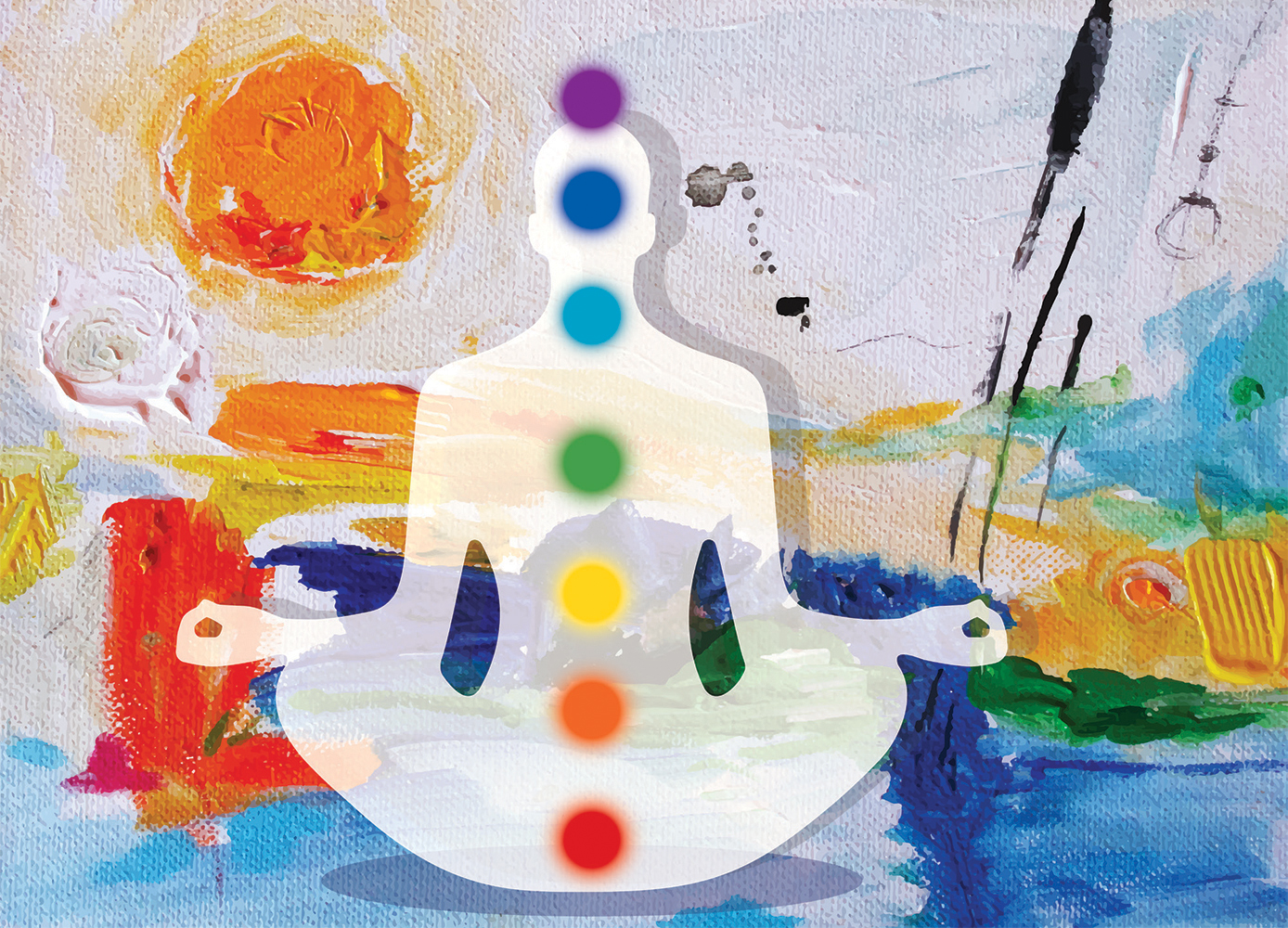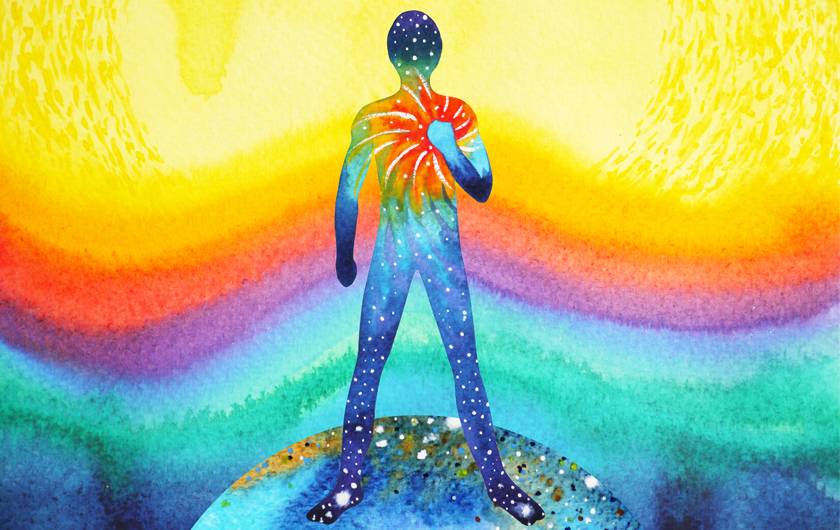The goal of art therapy isn’t the creation of masterpieces but improved physical and mental health
By Wendy Haaf
Photo: iStock/DrAfter123.
Art therapist Lucie Sarrasin is used to first-time visitors to her workplace arriving with a set of misconceptions about her chosen field. “I would say 80 per cent of people come into my art room and say, ‘I’m not creative at all. I don’t even know how to draw a straight line,’” she says. “And I say, ‘You’re in the right place, because you’re going to learn and have fun.’”
That’s not just because professionals such as Sarrasin (who have training in both psychotherapy and fine arts) can introduce participants to a variety of different media and techniques. For one thing, art therapy (and arguably, artmaking in general) is more about the doing than the end result, says Sarrasin, who works at the Quebec Cancer Foundation in Montreal as well as leading a group for women in later life at Laval’s Axion 50 Plus, a non-profit seniors’ body. It’s also a chance to rediscover the preschooler inside who plunged into fingerpaints or macaroni and glue with abandon.
“We’re all innately creative,” says Jazmine Tufford-Singh, a registered psychotherapist and art therapist in Kitchener, ON. “We just have different experiences of how that’s been nurtured in us, or perhaps not.”
There’s good reason to believe that this type of self-expression is more than just a nicety, but rather a need that, when fulfilled, promotes emotional, mental, and even physical well-being. In November 2019, the World Health Organization released a report that synthesized the findings of more than 3,500 studies showing that engagement in the arts confers benefits in the management and treatment of ailments ranging from mental illness to stroke and cancer (among other things, it reduces psychological and biological markers of stress) as well as in the prevention of health problems—for example, by reducing the risk for cognitive decline in later life.
According to recent Canadian research, participation in the arts can improve physical health and vigour, too. In one trial, not only did adults 65 or older who took part in weekly workshops at the Montreal Museum of Fine Arts see increases in well-being and overall quality of life, but nearly 30 per cent who fit the criteria for physical frailty at the start of the three-month study had moved into the “normal” category by the end.
“It was the first time that art activity demonstrated this kind of an effect,” says study lead, Dr. Olivier Beauchet, who is also the director of the RUIS McGill Centre of Excellence on Longevity (based at Montreal’s Jewish General Hospital) and a professor of geriatrics at McGill University. Another study by the same researchers focused on in-patients with dementia, who, according to the study, “suffer a higher rate of adverse outcomes including mortality” than non-dementia patients. The researchers found that participation in painting workshops was linked with a decrease in deaths during hospitalization.
For a closer look at what people get out of turning their hands to drawing, weaving, woodworking, and other arts and crafts, we talked with a handful of those who have witnessed the power of creation first-hand.
Distraction and Escape
The absorption experienced during an activity such as quilting or creating a collage from magazine images can provide a welcome holiday from a variety of difficulties, from day-to-day disappointments to momentous life events. Beth Foster of Brantford, ON, for example, found that painting—something she hadn’t done for decades—helped her deal with her grief after her mother’s death, as well as with the transition from her all-consuming career as a social worker to her life as a retiree. Art allowed her to concentrate on something positive and upbeat. “It’s a fun form of stress relief—focusing on the here and now,” she says.
According to Ann Pigott, an art instructor with the Veterans Arts program at the Parkwood Institute at St. Joseph’s Health Care London (ON), that kind of mental attention to a hands-on pursuit can allow people to “completely forget that they are sad or stressed out, or have anxiety or pain.”
Art can act as a portal to pleasant memories, too. “When I painted, I would think of how my mom used to enjoy when I’d produce something for her,” Foster says.
Pigott notes that the scent and tactile sensations of working with wood allow one of the people with whom she currently works (nearly all are Second World War veterans in their 90s) to revisit his teens, which was when he learned the craft from his father. “He said, ‘When I do woodworking, I remember my dad,’” she explains.
Emotional Exploration and Expression
Done in partnership with a professional who has the appropriate training, artmaking and discussing and reflecting on the artwork can facilitate self-exploration and understanding, according to the Canadian Art Therapy Association. (“Art therapist” is not a protected title; one way of finding someone with the appropriate training—at minimum a Master of Arts degree or a master’s level diploma in art therapy—is to use the “find a therapist” search at canadianarttherapy.org.)
“In art therapy, the purpose is to help people express their emotions and what they’re going through,” Sarrasin says. “It’s much easier to talk about your artwork than to talk about yourself,” she observes.
“It provides another layer of communication for people,” Tufford-Singh says. “We don’t always have the words to articulate what we’re feeling.” In such cases, an art therapist can work with a person to identify those emotions. “Art therapists don’t interpret the client’s work,” Sarrasin stresses. “We help them to interpret it.” One of the reasons that’s important, she explains, is that the meaning of colours, shapes, and other aspects of a piece can vary not just from one person to another but at different points in time for a single person.
In addition, art therapists can help someone simply learn to sit with his or her feelings, similar to the goal of mindfulness meditation. “In art therapy, you learn to honour your emotions,” Sarrasin says. “We don’t judge them; we accept them.”
This can be particularly useful during periods of grief, loss, and other types of transition. “Sometimes we just need that safe space to process and talk and work things through,” Tufford-Singh says.
Art therapy can also provide a safe outlet for releasing powerful or disturbing feelings, such as anger. For example, Sarrasin will set up a large piece of paper at which would-be artists can fling paint from a distance. And one previous client was able to work out her fury, frustration, and feelings of powerlessness at a difficult family situation by moulding little people out of clay and stabbing them—which had a calming effect. “She needed to feel some power,” Sarrasin says.
Similarly, choosing a medium and flexing creative muscles can restore some sense of control for someone who’s going through cancer treatment or whose daily routine is dictated by others due to living in an institutional setting. When people go to see Pigott, for instance, she greets them with “What do you want to do?” “That definitely makes them feel that they’re in the driver’s seat, and that’s pretty valuable.”
Connections
In addition to creating a conduit for one’s own emotions, art and art therapy can help build relationships. “It’s another point of connection, where the therapist can learn more about that person,” Tufford-Singh says.
Done in a group, art can spark conversations, forge friendships, and create communities with shared experiences and interests. For Beth Foster, taking an art class with some former co-workers provided a way to keep in touch; once the lessons were over, the group continued getting together once a month to share a meal, work on projects, and socialize. For both Foster and her friends, the get-togethers have offered a way to deal with a series of changes and challenges. “It’s an opportunity to get away from the stressors or to bring something out and say, ‘That was really hard,’” Foster says. “It’s almost like a bit of therapy for them.”
Similarly, in one of Sarrasin’s closed groups, participants share a unique bond: ranging in age from 20 to 39, they experienced their cancer diagnoses and treatments at very different points in life than did most cancer survivors. Often those who’ve been through such an experience want to protect their loved ones and are therefore unwilling or unable to talk with those close to them about how they really feel. However, “sharing with people who have been through the same thing allows survivors to say what they couldn’t say to their parents or to their spouse or kids,” Sarrasin says. “It’s a nice place to help each other; it’s very powerful,” she adds.
Art also has the potential to bring together people who may outwardly have very little in common. For example, a group of Grade 10 history students in London, ON, who were scheduled to travel overseas for the 75th anniversary of D-Day paired off with veterans at Parkwood to create felt poppies, which the teens took on their trip and left behind in a place of their choosing. “They then came back and shared their experiences with our veterans,” Pigott says. “That was pretty poignant.”
Purpose and Productivity
“Unfortunately, as we age, we start to lose some of our abilities,” Pigott says, and sometimes “people start to think that they’re really just useless.” Going down to the wood, clay, or textile studio to throw a pot or weave a table runner provides the feeling of doing something worthwhile or useful with one’s time. “The veterans in particular have this work ethic,” she says. “Their attitude is, ‘I may be living in a facility, but I can still make things that people want and I might even get some money in my pocket.’[Parkwood Institute holds an annual arts and crafts show and sale.] That’s incredibly satisfying for them.”
But even just doing the work with no intention of selling or even displaying the art created is rewarding. While inactivity and aimlessness can contribute to feelings of sadness or depression, “when I actually do something, that lifts those feelings,” Foster says. “It’s like I’ve accomplished something.”
That drive to do something meaningful can even offer solace following the death of a loved one or at the end of life. “People who have lost a child can express the void that loss created in their lives, as well as the love they had for that child,” Sarrasin says. Another of her former clients, who had terminal cancer, feverishly created individual art pieces for each of her three grandchildren, labelled with their names and what she loved about them. “When the project was completed, she was so happy. She said, ‘Now I’ve got something to leave for my grandchildren; they will remember me,” Sarrasin says. “And that she took the time to do it when she was so sick meant a lot to the family.”
Challenge and Discovery
The challenge of learning something new, whether it’s an entirely unfamiliar art form or just a novel technique, is among the cerebrally stimulating activities that have been linked with better brain health and function in later life. And the willingness to take such a leap can confer other benefits, as well.
“I would say that 98 per cent of people find that they’re a lot more creative than they thought,” Sarrasin says. “Imagine coming in and learning how to finish a beautiful painted silk scarf,” Pigott says. “You’re going to feel like a million bucks. And that feeling translates to other aspects of life.”
Still, turning out something pleasing to the eye shouldn’t be the goal. In Sarrasin’s experience, immersing oneself in an art project without caring about the result can help you overcome a fear of failure, practise problem-solving and decision-making, and gain self-confidence—regardless of the outcome of a particular project.
“People want to make something that works, of course, but if it doesn’t work, they learn from that, too, and we start again,” Sarrasin says. “In art therapy, we care about the process. We always say the process is more important than the product, and in life, it’s the same thing.”
And it’s never too late. Foster says she knows of a man in his 90s who, upon taking an art class with his daughter, “discovered he had significant talent.”
Pigott, too, has seen people around the same age with no previous artistic experience “discover a flair for putting colours together or for weaving. It’s never too late to develop your creativity and learn new skills. The people I work with—the majority are in their 90s and a couple are over 100—still want to learn. I find that incredibly inspiring.”
“I see art as very life-giving,” Foster says.




